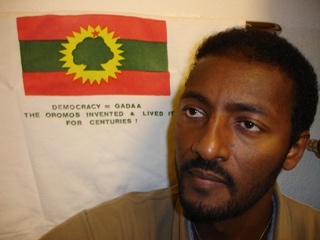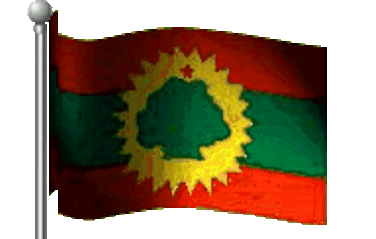Oromo Orthodox Criticism of the Abyssinian Misuse of Orthodox Christianity in Politics

By Mr. Dirribaa Ejere
First and foremost, I would like to make clear right at the outset that I am not against any sort of religion, ethnic group and society in general. Respecting and accepting all human beings, irrespective of their geographical location, religion and race is my personal guiding principle inherited from Oromo ‘Safuu’.
Parallel with that principle is my inclination to thoroughly disapprove of those who engage in acts of moral turpitude, thus depreciating the entire Mankind. This attitude became the reason of composing the present article that I believe will shed light on several historical – sociological aspects of the Abyssinian tragedy that went unnoticed for too long.
Sharing personal experience and analyzing characters of the Abyssinian society will certainly help many understand the Abyssinian paradox. I will concentrate on the ways the successive Abyssinian ruling classes have misused my own religion, Orthodox Christianity, against myself and against the Oromo Nation in general.
The targets of these actions have been the justification of the Oromo subjugation, the termination of the Oromo massive resistance to the Amhara and Tigray rulers, and last but not least the obliteration of the Oromo Culture.
Having realized their targets and identified their means was a matter of great and persistent disappointment for me; I am seriously considering getting back to my original Oromo religion, as I have enough of the abuse made by the Orthodox Church, an ever ongoing process.
By the term ‘Abyssinian ruling classes’ I denote here the Abyssinian regimes that helped establish the still existing despotic system, and the Ethiopic Orthodox priests who are directly or indirectly affiliated with the Abyssinian governing body.
Before my presentation as to how Orthodox Christianity is misused at the hands of the Abyssinian ruling classes as a cultural – political tool against the Oromos and other Kushitic nations of the South, I would like to draw a brief portrait of the traditional Oromo religion.
Waaqeeffannaa
Prior to the adoption of Orthodox Christianity, the introduction of Islam, and the diffusion of other Christian denominations (example Pentecostal) among them, the Oromos practiced our original and traditional religion known as Waaqeeffannaa.
Waaqeeffannaa is the belief in One Waaqayoo/Waaqa (One God). For the Oromos, Waaqa is the Creator of everything, Ultimate Source of Life, Omnipresent, Infinite, and Incomprehensible.
Waaqa can do and undo anything; He is Pure, Intolerant of injustice, crime and all falsehood. The manifestation of the One Waaqa takes place through saints called Ayyaana (male) and/or Ayyaantuu (female).
An effective relationship between Ayyaana and Oromo is often maintained by means of Qaallu (male) and/or Qaalittii (female). Qaallu is equivalent to a bishop in the Christian religion and to Imam in the Muslim religion. The place of the worship of the Qaallu is Galma.
Amhara Tyranny
For many long years, the Abyssinian ruling classes have considered as of paramount importance for them to inculcate false ideas in the minds of the Oromos, Sidamas, and other oppressed peoples.
For an idea to serve the interests of the ruling classes, it must diffuse among the subjugated people the belief that it would be either impossible or wrong (or preferably both) for them to organize resistance and attempt to defeat their exploiters.
The real essence of this systematic approach to permanent subjugation evolves around ways to keep the Oromo masses passive and loyal, divide them against one another, and finally lead them to docile identification with the ruling class.
Political Misuse of the Ethiopic Orthodox religion by the Amhara tyrants
Consequently, the Ethiopic Orthodox religion is manipulated and misused by the Abyssinian ruling classes in order to serve such a political approach. At the onset of the invasion, the first phase of attack on Oromo Culture by the Abyssinian ruling classes was aimed at the traditional Oromo religion.
The Orthodox Church, as misused by the Abyssinians, has been instrumental in equating Waaqeeffannaa to Paganism and Satanism, thereby degrading the entire Oromo religion, and creating a false pretext for the Oromos to do away with their own – monotheistic and aniconic – religion and culture.
Quite indicatively, the Abyssinian ruling classes, by means of educators, administrators, etc. intentionally confused the Oromo word ‘Qaallu’ and the Amharic (Abyssinian) word ‘Qaallicha’ for being one and the same.
The Abyssinian ‘Qaallicha’ is a fraudulent person, who resorts to witchcraft and black magic as a means of living. He is socially despised for collecting remuneration by threats and other miserable means.
A lofty Qaallu and an unholy Qaallicha
On the other hand, and contrarily to the Abyssinian ruling classes’ effort to diffuse confusion and therefore negatively and deceitfully portray the Oromo word, ‘Qaallu’ is for the Oromos a religious and ritual expert, who has established a special spiritual relationship with an Ayyaana, who becomes the source of his illumination, opening for him every now and then new spiritual and transcendental paths.
By interpolating Christian Orthodox contextual terms confusingly and for their political purposes, the Abyssinian ruling class disparaged the Oromo term and concept ‘Qaallu’ as evil, therefore promulgating all kinds of castigation against the persons, and in parallel discrediting them socially and religiously.
This is a calculated political machination intended to debilitate the Oromo Qaallu institution and with that the entire Oromo religion and culture. Not only the term Qaallu has been purposely confused, but also its place of worship has been intentionally and fallaciously misrepresented.
Oromo Places of Worship
Besides Galma, places of Waaqa worship and Qaallu rituals involve space under huge trees, areas adjacent to large bodies of water, peaks and cliffs of high mountains, etc.
Further misusing Ethiopic Orthodox Christianity, the Abyssinian ruling classes disseminated volumes of malicious and fallacious propaganda purportedly concerning an eventual worship of trees, rivers, etc. by the Oromos.
Through extensive use of these misrepresentations and falsifications, the Oromo Qaallu ritual places have been ignominiously and inhumanly desecrated and almost completely eradicated, as Ethiopic Orthodox churches have been erected in complete replacement and effacement of the Oromo sacred places.
Irreecha – a Millennia long Kushitic Religious Ceremony prosecuted
Just before the beginning of the harvest season every year, the Oromos attend a prayer ceremony (thanksgiving festival) called Irreecha / Irreessa. Irreecha ceremonies have to take place alongside a lake and / or river meadows whereby now the Ethiopic Orthodox Church takes its holy Tabot (tablets) for the special yearly festival, the ‘Timqet’.
Under the communist regime of Mengistu Haile Mariam, the Qaallu and the Irreecha were proclaimed as absolutely illegal and those spotted practicing it risked imprisonment.
A conspicuous irony here is that the Abyssinian ruling classes denounce the Oromos intentionally for erroneously worshipping rivers, while they themselves take the holy Tabot to rivers at the spot where Oromos have been celebrating Irreecha for ages before the Abyssinian invasion.
This political choice is nothing but arrogating places that are not theirs, and depriving the Oromos of their ritual places; the entire process consists in an obvious misuse of the Ethiopic Orthodox Church.
Not only Oromo’s ritual places, but also the Oromo fertile lands and residential areas have been expropriated again through use of the same Ethiopic Orthodox Church unabashedly, and without an iota of remorse.
Unholy and unethical use of Orthodox sacred objects by the Amhara tyrants
The fertile Oromo lands and residential areas that the Abyssinians deemed as strategic place for their domination are first pried into, after which the Tabot is transported dissemblingly from one region to another in the direction of the land they had an eye on. Upon arrival at the fertile land and/or strategic residential area, they devise a shameful fib, saying that the Tabot refused to move.
Consequently a church has to be built there, implanting subsequently the Abyssinian ruling classes’ despotic system, and uprooting the Oromo residents.
During Ethiopic Orthodox Church ceremonies, some Abyssinian preachers resort to political discourse instead of teaching spirituality. Unimaginable but true, flags are waved inside the churches!
Furthermore, Oromo Qubee is despised publicly in the church, etc. Numerous other examples can be given that evince how Ethiopic Orthodox Christianity is misused by the Abyssinian ruling classes.
All these practices clearly demonstrate, beyond any peradventure of doubt, that the Abyssinian ruling classes have left no stone unturned, and have stopped at nothing to appropriate the Oromo land and eradicate the Oromo Culture.
The Ethiopic Orthodox Church has been extensively and repeatedly misused in order to create mitigating circumstances that militate against uprising and public revolt.
The oppressed nations have every right to resist this implacable injustice, and will come up against the stone wall of Abyssinian ruling class brutalism.
Especially the ordinary Abyssinians and others who are followers of Ethiopic Orthodox Christianity have to react and never tolerate anymore the unethical misuse of their religion.
Victory to the oppressed!



0 Comments:
Post a Comment
<< Home